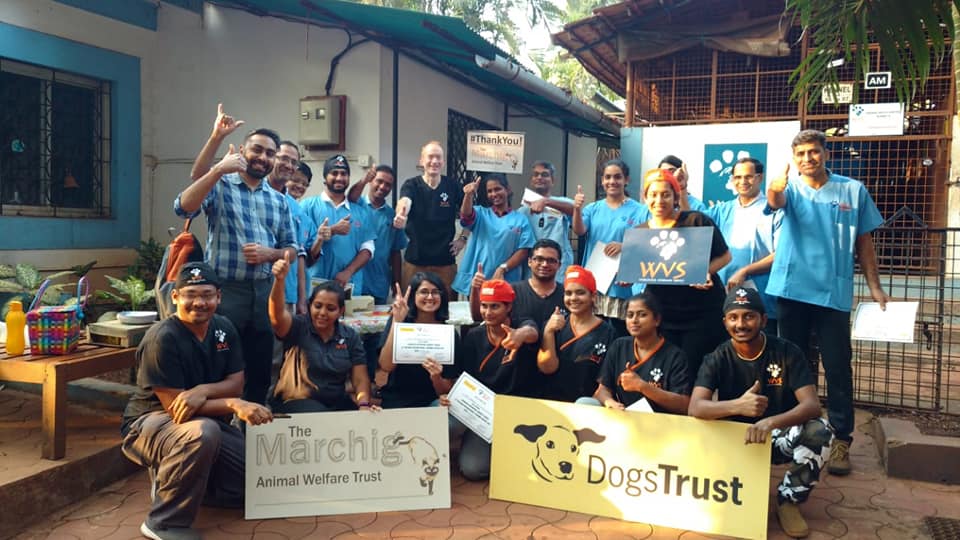We were delighted to host Dr Andy Moores, a orthopaedic specialist from Anderson Moores in the UK, at our Hicks ITC this year. This is his story.

I had been treating Luke Gamble’s own dog last year, and at one of Luke’s visits to Anderson Moores with Angel he casually asked if I knew any orthopaedic surgeons who would be willing to go out to India to teach for WVS. I don’t think Luke was really expecting much of a response but I was actually really keen to get involved. Years ago, when I was a GP vet I used to volunteer treating the dogs of the homeless in Brighton. From time-to-time I have wondered how it might be possible to also volunteer abroad but the opportunities to do this as a specialist small animal orthopaedic surgeon seemed pretty limited. Luke’s request was really enticing and after being provided with some more details, including some information about the Hicks centre and the team out in Goa, and I was sold. I managed to convince my business partners at Anderson Moores to let me go out to the Hicks centre for a week (in truth they did not need much persuading – they were very supportive of the idea) and a week in February was booked. The plan was to run two two-day courses covering basic orthopaedic procedures. When the courses were advertised though, there were around 90 applications for places in the first 24 hours. To try to accommodate as many delegates as possible we decided to run an extra course – a single day course for slightly more experienced vets.

I flew into Goa on a Sunday and I started teaching the next day. The hall of a local seminary was used for lectures in the mornings and then in the afternoons I would run practical surgery sessions in an area of the Hicks centre. We were very fortunate that Veterinary Instrumentation, a UK veterinary equipment supplier, had kindly donated some external skeletal fixation kit, which I took out with me, so a large part of the practical sessions involved demonstrating fracture repair techniques using this kit. The delegates had travelled from all across India to attend the courses and their enthusiasm was infectious. From talking to them, it was clear that they received virtually no small animal orthopaedic teaching during their training and so they were extremely grateful for the opportunity to learn these techniques. It was an incredibly busy week – we ran five days of back-to-back teaching and taught 82 vets in total. It was exhausting, but also incredibly satisfying.

During the week I was at the Hicks, a young stray puppy was brought in by Jill, one of the centre’s volunteers. We guessed the puppy was around four months’ old. Jill had found the puppy near the police station and so had called her Polly. Polly couldn’t walk on one of her hindlimbs and x-rays at the centre confirmed a complex femoral fracture. Any other week and the limb would probably have been amputated, but I thought we could probably save the limb. I was flying back on the Sunday so we lined up the Saturday for some surgery. We spent the Friday evening after the last course rummaging through boxes of old instruments and implants trying to find some kit that might be suitable for Polly.

The next day she was anaesthetised and taken into the Hicks operating theatre. She was expertly spayed by one of the Hicks’ vets first and then we both operated on the femur.

One of the big concerns with any orthopaedic surgery where implants are used is post-operative infection. When I operate at Anderson Moores I wear a sterile gown and gloves, as well as a hat and mask, to reduce the risk of infection. Here, we had gloves, hat and mask but no gowns so we fashioned make-shift gowns by cutting holes in sterile plastic drapes!

Puppies of Polly’s age are brilliant at healing, and Polly’s fracture was already starting to heal with scar tissue; however, the bone fragments and knee were in the wrong position. The scar tissue had to be cut out and then it was possible to get the bone fragments and knee back into alignment before stabilising them with a pin, plate and screws. The end result was hopefully a pretty good repair. Just a couple of hours after waking up from surgery Polly was recovering well and was taken home by Jill on her moped! Since my return to the UK, Jill has been keeping me up-to-date with Polly’s progress and it sounds like she is making great progress.
I had mixed emotions on leaving Goa. I had been away for eight days – two were spent travelling, five teaching and one operating on Polly. I was exhausted and looking forward to getting home (although I was back to work the next day!). At the same time though, I was sad to leave. It was an amazing experience and I really feel that we managed to make a difference to the vets that came to the courses, and how they will treat their orthopaedic patients in the future. I also made some great friends at the Hicks centre. Karlette who runs the centre was awesome – she made the logistics of my stay and the courses very easy. Working alongside Karlette at the Hicks is an awesome team of young WVS vets and technicians who were also brilliant. Thank you to all of you and to Luke for the invitation!

Looking forward to next time!
Andy Moores BVSc DSAS(Orth) DipECVS FRCVSAnderson Moores Veterinary Specialists, Winchester, UK@OrthoVet